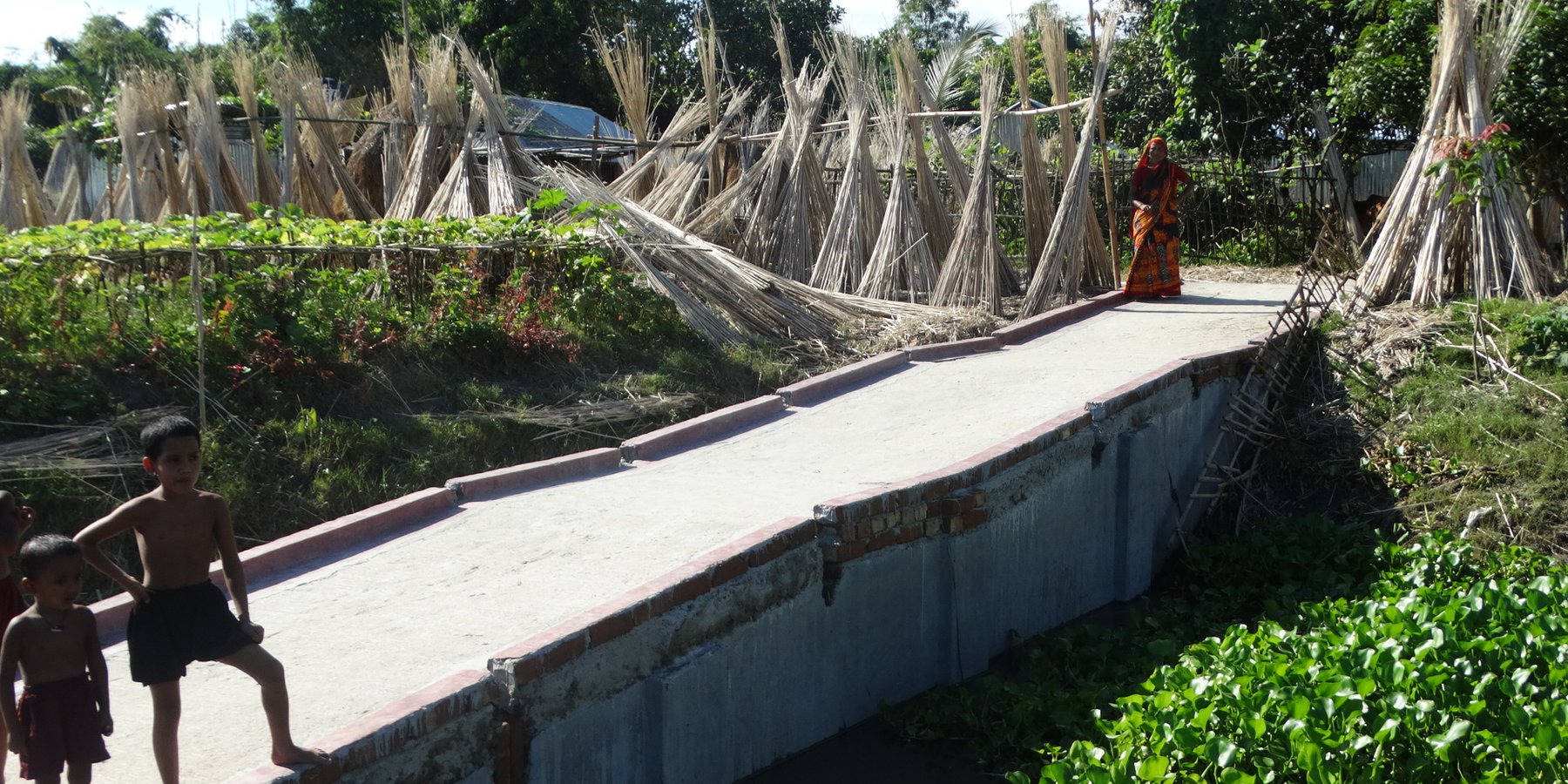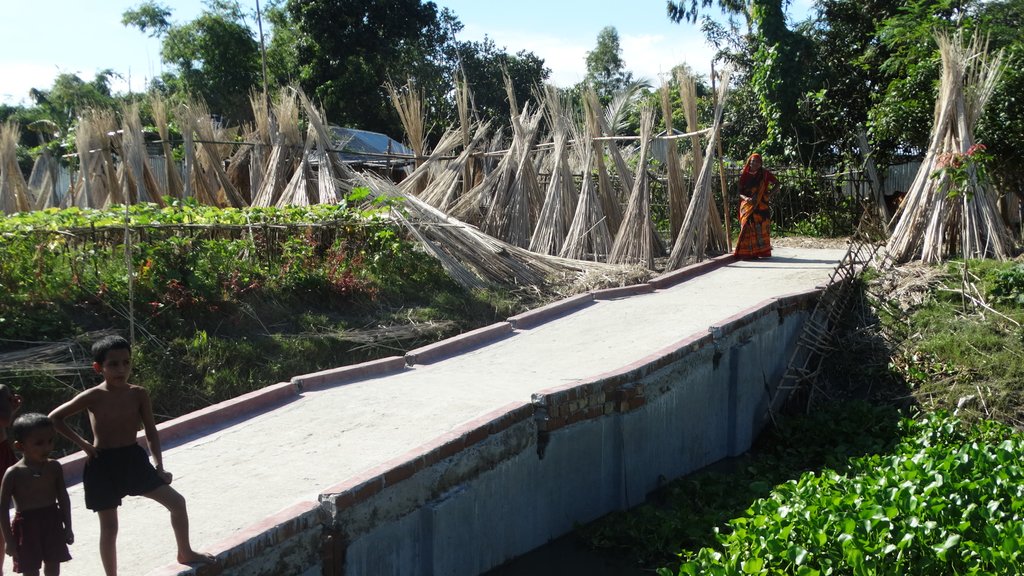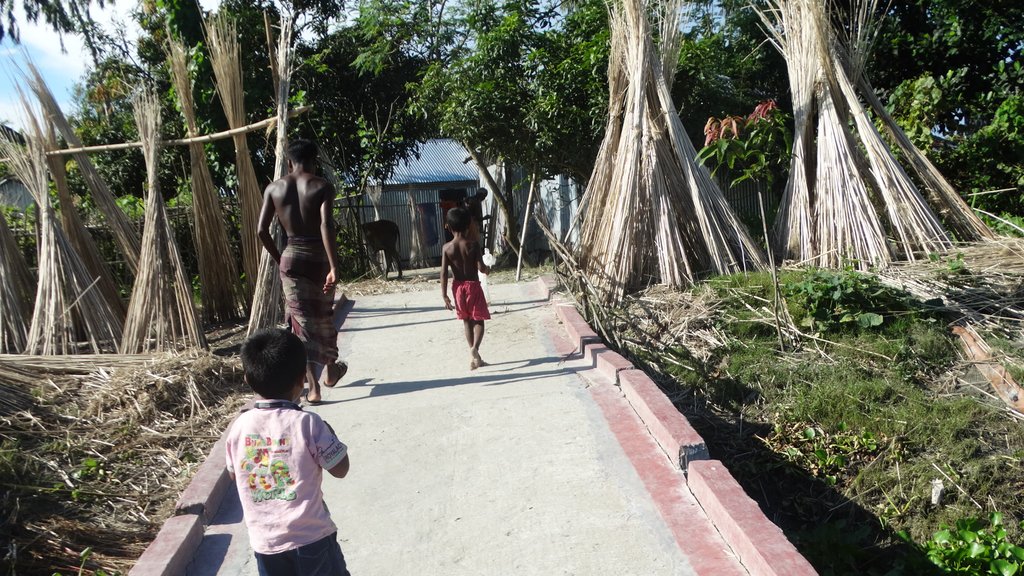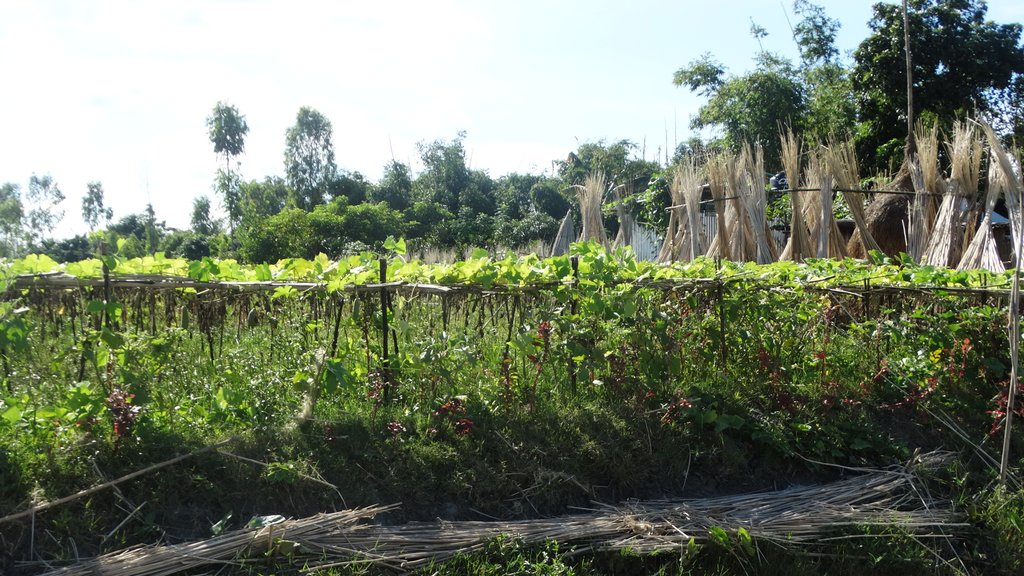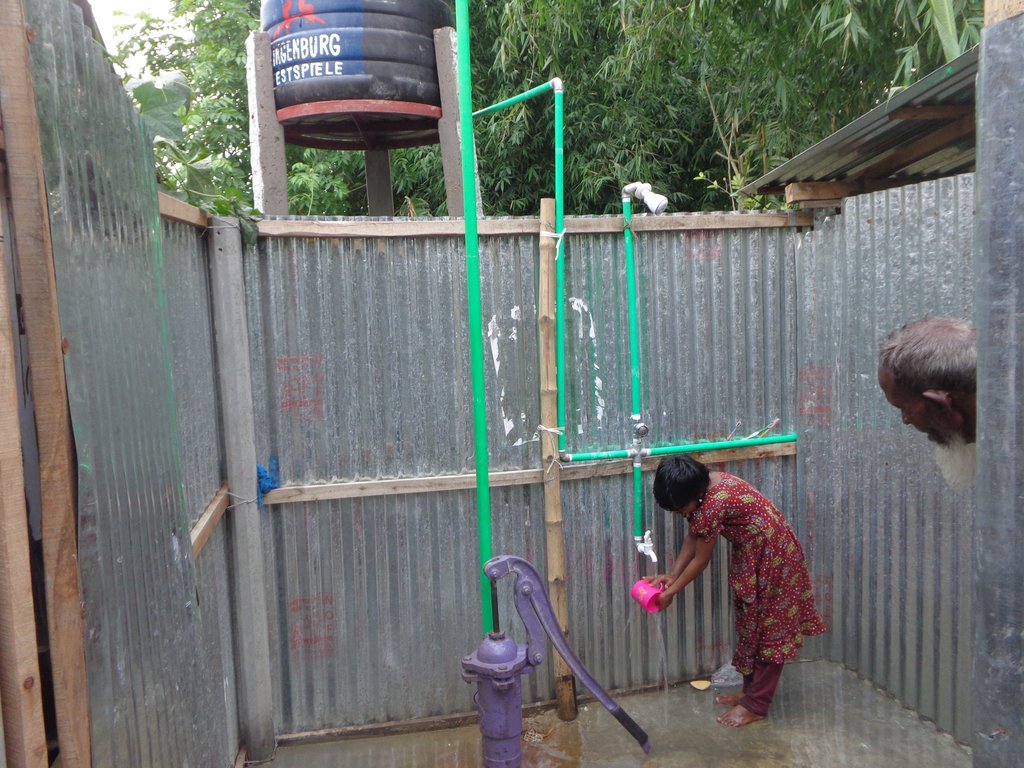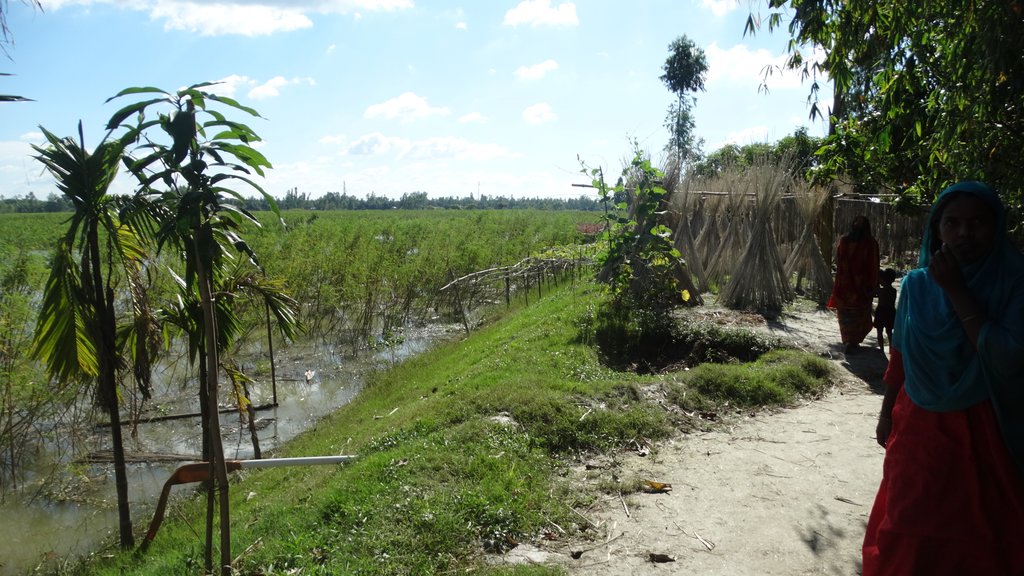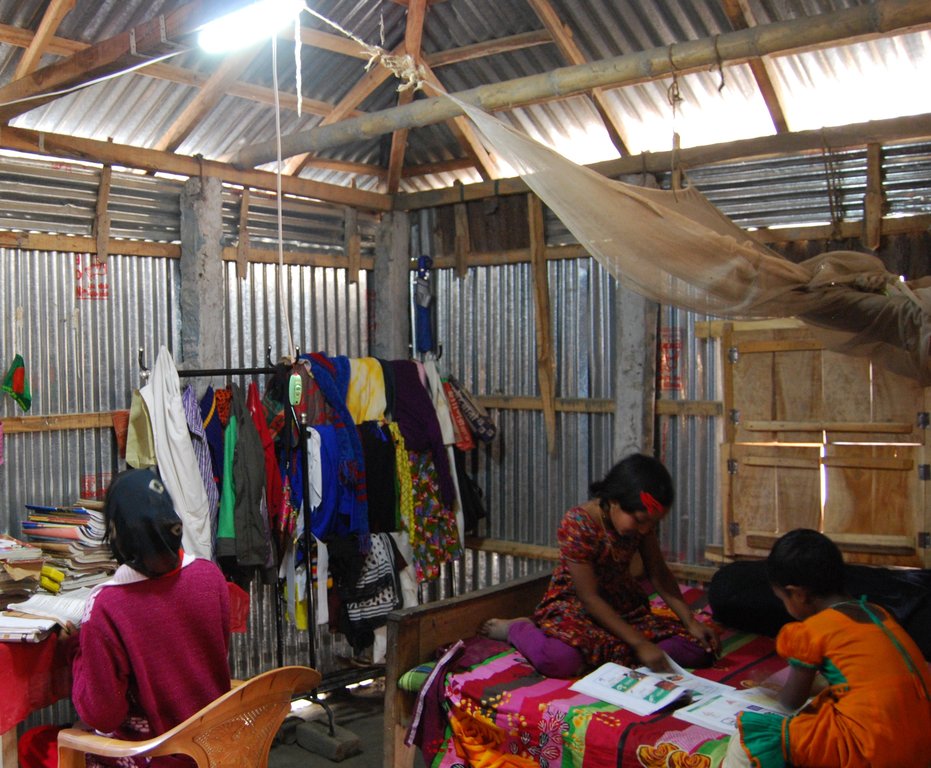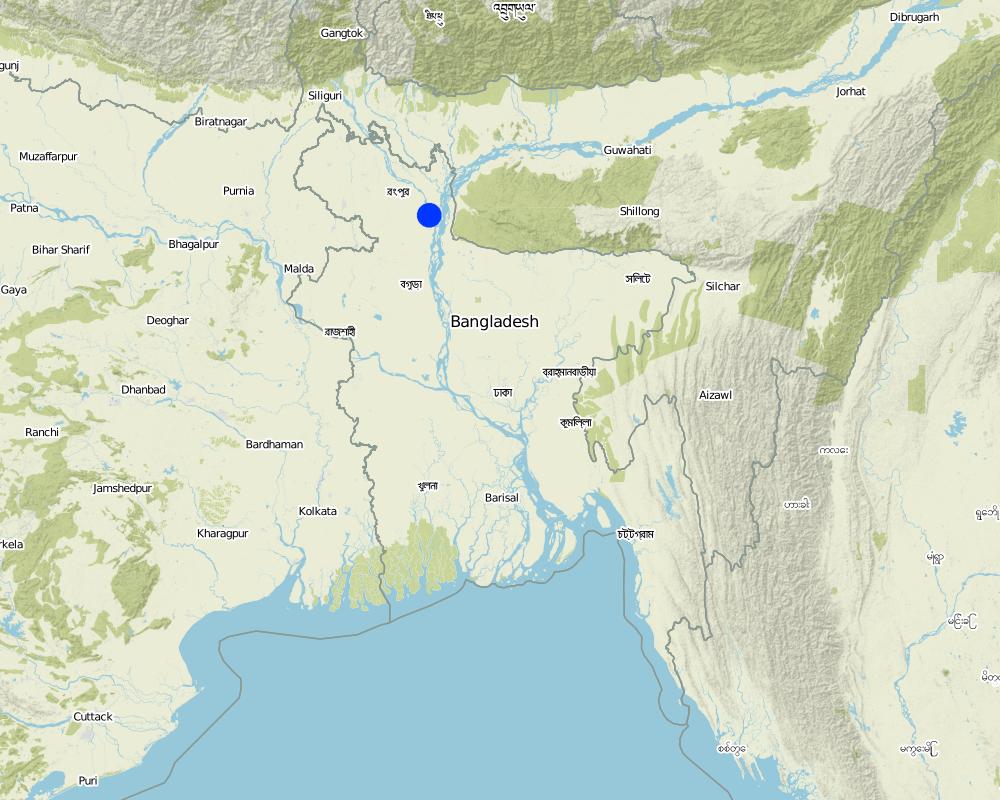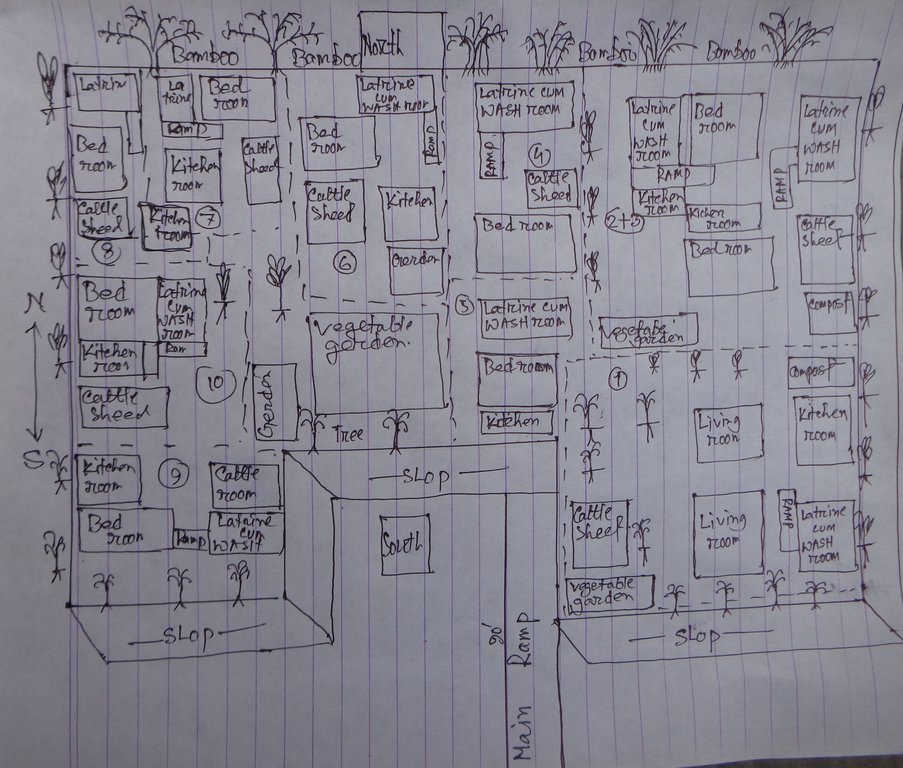Disability inclusive, flood resilient cluster village [Бангладеш]
- Создание:
- Обновить:
- Составитель: Subir Saha
- Редакторы: Subir Saha, Manuel Rothe
- Рецензент: Alexandra Gavilano
"Protibandhita Bandhob Bonna Sohisnu Gucca Gram"
technologies_2005 - Бангладеш
Просмотреть разделы
Развернуть все Свернуть все1. Общая информация
1.2 Контактные данные специалистов и организаций, участвующих в описании и оценке Технологии
Название проекта, содействовавшего документированию/оценке Технологии (если применимо)
Book project: where people and their land are safer - A Compendium of Good Practices in Disaster Risk Reduction (DRR) (where people and their land are safer)Название организации (-ий), содействовавших документированию/оценке Технологии (если применимо)
Christoffel Blindenmission (CBM) - Швейцария1.3 Условия, регламентирующие использование данных, собранных ВОКАТ
Когда были собраны данные (на местах)?
09/11/2016
Составитель и ответственный(-ые) специалист(-ы) согласны с условиями, регламентирующими использование собранных ВОКАТ данных:
Да
1.4 Декларация по устойчивости описываемой Технологии
Вызывает ли описанная здесь Технология проблемы деградации земель настолько, что ее нельзя назвать природосберегающей?
Нет
Пояснения:
Not problematic with regard land degradation. It provides efficient and sustainable use of available land resources.
1.5 Ссылка на Анкету (-ы) по Подходам УЗП
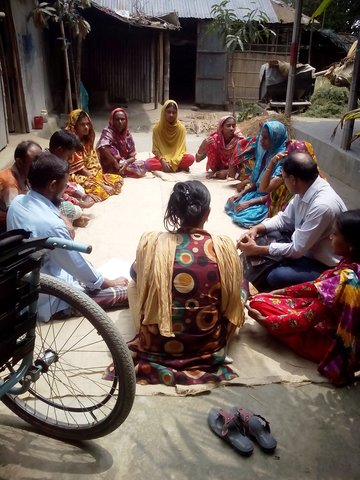
Disability inclusive Disaster Risk Reduction [Бангладеш]
The disability inclusive approach is centered around the meaningful contribution and leadership of persons with disabilties during the entire project management cycle, from the planning stage to the evaluation of the impact of a project. It contributes to empowering them to overcome social exclusion and recognizes their needs and priorities …
- Составитель: Subir Saha
2. Описание Технологии УЗП
2.1 Краткое описание Технологии
Определение Технологии:
The inclusive, flood-resilient cluster village provides safe housing, food security and income generation for multiple families, including persons with disabilities, in a highly flood prone area of Gaibandha District in northern Bangladesh. The land was raised above flood level and is protected by deep rooted fruit trees to prevent soil erosion and provide income for the land users.
2.2 Подробное описание Технологии
Описание:
The inclusive, flood-resilient cluster village was introduced in a rural area with a high risk of recurring monsoon floods. The purpose of the technology is to provide safe housing, safe shelter for livestock, food security and income generation for ten families, including persons with disabilities.
The main components of the technology are:
1) The raising of a piece of land by seven feet (213cm), to three feet (91cm) above expected highest flood levels. Solid soil was banked up to encircle a 30'000 square feet (roughly 50x57m) piece of land and then the space within was filled up with sand collected from a nearby river bank. A one-foot layer of solid soil was added to cover the entire area.
2) The protection of the raised land from soil erosion during floods by planting a combination of deep-rooted fruit- and medicine trees around the border of the raised land. The trees include a number of different types of deep-rooted and light-rooted fruit trees and one type of medicine tree, Azadirachta Indica, locally known as "Neem". In addition, the slope of the border area was covered by grass turf to protect the soil from being washed out by rain. Two types of deep-rooted and flood resistant grasses were used. A drainage system was installed to facilitate water runoff.
3) The planting of a 150 square feet (14m2) commonly used homestead vegetable garden at the center of the cluster village. The cultivated vegetables include red spinach, jute leaf, basella leaf, spinach, radish, cabbage, okra, bottle-guts, cucumber and beans, allowing for a summer and a winter harvest. Together with the fruit trees, the vegetable garden provides food security during prolonged flooding. They also provide improved nutrition and income generating opportunities through selling of a part of the harvest in the market.
4) Making the village accessible for persons with disabilities through different accessibility measures, including the construction of a ramp, connecting the cluster village entrance with the road, and of accessible common Water-, Sanitation- and Hygiene (WASH) facilities, including a latrine, deep bore hole water source and water storage tank.
5) Installation of a solar panel to ensure uninterrupted, flood-resilient power supply. The level of power supply is sufficient to ensure coverage of electricity needs during flood season, when regular supply is around 15% below annual average.
The Cluster village was constructed as part of a disaster risk reduction project by CDD (Center for Disability in Development) from Bangladesh, with the support of CBM (Christoffel Blindenmission), an international development organization and funded by a donor from Germany. The main cost for inputs were provided to the land users by the project, including rent of construction machinery, paid labor, soil and construction material for the ramp and WASH facilities. The land users contributed labor and seedlings for the planning of the border trees and the homestead vegetable garden.
The main benefits of the technology from the perspective of land users are the protection it provides for houses and livestock, which would otherwise be in danger of loss during floods. The availability of food, water and electricity allows land users to remain in their homes during floods and avoid evacuation and the risk associated with it, including for example protection risks or the risk of theft. The flood protected vegetable gardens and fruit trees provide a year-round, sustainable source of food and income, providing food security and improved nutrition. The Neem tree provides medical and hygiene uses of the branches and leaves.
The cluster village is used as a safe space for the land users and other members of the community and their livestock during floods. Land users who are persons with disabilities or elderly benefit from the accessible infrastructure. With multiple families sharing land, the cluster villages provides optimal utilization of land resources. An additional benefit mentioned by land users is that the joint use by multiple families led to a more progressive social culture.
2.3 Фотографии, иллюстрирующие Технологию
2.4 Видеоматериалы, иллюстрирующие Технологию
2.5 Страна/ регион/ места, где применяется Технология, информация о которых собрана в данной Анкете
Страна:
Бангладеш
Административная единица (Район/Область):
Gaibandha District
Более точная привязка места:
Horipur Union, Sundargonj Sub district,
Пояснения:
Kani Charitabari, Horipur Union, Sundargonj sub district, Gaibandha District.
Map
×2.6 Сколько лет применяется данная Технология
Год начала реализации:
2016
2.7 Внедрение Технологии
Укажите, как именно Технология УЗП была внедрена:
- через проекты/ внешнее вмешательство
Пояснения (тип проекта и т.д.):
The technology was introduced as part of a disaster risk reduction project, implemented the Center for Disability in Development (CDD) with the support of Christoffel Blindemission (CBM) and with participation and leadership of the local community. The project was financially supported a group of donors from Germany.
3. Классификация Технологии УЗП
3.1 Основные цели и задачи реализации Технологии
- снижение риска стихийных бедствий
- адаптация к изменению климата / экстремальным погодным явлениям и их последствиям
- создание благоприятных экономических условий
- создание благоприятных социальных условий
3.2 Текущий(-ие) тип(-ы) землепользования на территории, где применяется Технология

Населенные пункты, инфраструктура
- Жилищная застройка, другие здания
3.3 Дополнительная информация о землепользовании
Обеспеченность водой участков, где реализуется Технология :
- сочетание богарных и орошаемых земель
Число урожаев за год:
- 2
Поясните:
Summer and winter
Поголовье скота на единицу площади (если применимо):
Livestock are available in every household.
3.4 Категория УЗП, к которой относится Технология
- Улучшение почвенного/ растительного покрова
- мероприятия по влагозадержанию и снижению эрозии почв на склонах
- приусадебные участки
3.5 Распределение Технологии по площади
Охарактеризуйте пространственное распространение Технологии :
- примененяется точечно/ на небольших участках
3.6 Мероприятия УЗП, выполняемые в рамках Технологии

Мероприятия с использованием растительности
- Р1: Древесный и кустарниковый покров
- Р2: Злаковые и многолетние травянистые растения

инженерные мероприятия
- И7: Водосборное/ водопроводное/ оборудование для орошения
- И8: Санитарные/ водоочистные сооружения
- И9: Укрытия для растений и животных
- И10: Энергосберегающие мероприятия

управленческие мероприятия
- У1: Смена типа землепользования
- У2: Изменение формы/ интенсивности хозяйствования
- У6: Управление отходами (переработка, вторичное использование, снижение количества отходов)
3.7 Основные проблемы деградации земель, на решение которых направлена Технология

водная эрозия почв
- ВЭп: поверхностная эрозия/смыв верхних почвенных горизонтов
- ВЭрб: эрозия речных берегов
3.8 Предотвращение и снижение деградации земель, или восстановление нарушенных земель
Укажите цель Технологии по отношению к деградации земель :
- предотвращение деградации земель
- снижение деградации земель
4. Технические характеристики, мероприятия по практической реализации, вложения и стоимость
4.1 Технический рисунок, иллюстрирующий Технологию
4.2 Спецификация / пояснения к техническому рисунку
The drawing shows the layout of the disability inclusive, flood resilient Cluster village. The components of the technology are:
Raised land/plinth: 1) Purchase of land of a total area of 18'000 square feet (ca. 40x40m). Land ownership transferred to joint ownership of 10 families. 2) Collect 15'000 cubic feet (425m3) of solid soil from different pieces of land in the community. The soil was donated by members of the community, who were either related to the land users of the cluster village or donated in support of the construction of a safe space which can be used by the community during floods. 3) Banking up of 3 feet (91cm) of solid soil along the borders of the land. 4) Filling of area with 140'000 cubic feet (3965m3) of sand, extracted from a nearby riverbank with a rented sand extraction machine, raising the land to 6 feet (183cm). 5) Covering the entire area with one additional foot of solid soil, rasing the land to 7 feet (213cm), which means 3 feet (91cm) above the maximum expected flood levels.
Soil protected through deep-rooted trees: 1) Planting of deep-rooted and light-rooted fruit trees, surrounding the entire border of the raised land. The trees include deep rooted fruit trees like mango, black berry, jack-fruit, guava, coconut and areca nut, light-rooted fruit trees like banana and Papaya, a deep-rooted medicine tree, locally called "Neem" and the light-rooted Dhol Kalmi tree (pink morning glory). The number of deep-rooted threes was 100, with a spacing of around 5 feet in between each. They were planted to cover the entire perimeter of the raised land. In between the deep-rooted trees, 60 light-rooted trees were planted. In front of the deep-rooted trees, 60 bamboo bushes were planted to provide additional protection from wind and rain. 2) Turfing of the entire slope surrounding the cluster village with two flood resistant grasses: Durva (Cynodon dactylon) and Catkin grass. 3) Installation of a central drainage system with 15 plastic pipes ensuring water runoff from the wastewater pond.
Road access through ramp: The connecting ramp of the cluster village is 90 feet length, 6 feet width. There are five landing point of this ramp with smooth slopping. The construction material includes class one brick, brick stone, cement, sand, polythene and red oxide color for color contrast, which is appropriate for low vision and visually impaired persons. There is a 5 inch border on both sides of the ramp for safe movement of a wheel chair user.
Accessible household water and sanitation facilities: Latrine and wash-room are constructed for every house in the cluster village, following universal design standards. Latrines are connected to the wash room and the main house through ramps. There is a railing on both sides of the latrine and the entrance is wider for access of a wheel chair users. Water system for the latrine and wash room is provided from a water tank on three pillars behind the latrine, which is also connected to the main house for provision of drinking water. The tank is filled by hand pump ('magic pump') which functions with minimal hand pressure. The WASH facilities are accessible and usable by everyone including persons with disabilities, pregnant women or aged persons.
Home vegetable gardens: Every household has an individual homestead vegetable gardens where land users cultivate seasonal vegetables year-round. Gardens vary in size between averaging about 1.5 decimal (60m2) in size and are surrounded by bamboo fencing. The land owners are using organic fertilizer/compost for the vegetable production of their choice. By using cow's manure and wastage they are producing the compost in the behind of their houses in a ditch.
Solar system: A mini solar system is installed on the roof for each house by using a small panel with a 12-volt battery . Each system has the capacity of providing power for light for 8 hours. An introduction to system maintenance was given to the land users by the provider of the solar system.
4.3 Общая информация по необходимым вложениям и стоимости
Уточните, как рассчитывались затраты и вложения:
- на технологическую единицу
Укажите единицу:
Cluster village
Укажите объем, длину и т. д. (если уместно):
18'000 square feet piece of land
другая/ национальная валюта (название):
Bangladeshi Taka
Укажите обменный курс между долларом США и местной валютой (если уместно): 1 доллар США =:
80,0
Укажите среднюю дневную заработную плату наемных работников:
300
4.4 Мероприятия, необходимые для начала реализации
| Деятельность | Тип мероприятия | Сроки | |
|---|---|---|---|
| 1. | Selecting the place for cluster village construction | Управленческие | During rainy season in 2015 |
| 2. | Establish collaboration with 10 families who will become land users | Управленческие | December 2015 |
| 3. | Land Raising & Ramp construction | Инженерные | December 2015 to March 2016 |
| 4. | Reconstruction the existing houses of the land users on the raised land | Инженерные | April 2016, before onset of rainy season 2016 |
| 5. | Planting of deep- and light-rooted fruits trees, bamboo bushes and grass turfing along the boundery | Агрономические | February 2016 to March 2016 |
| 6. | Install accessible water & sanitation system | Инженерные | April-June 2016 |
| 7. | Establish home garden in front of each house | Мероприятия с использованием растительности | June-July 2016 |
| 8. | Install mini solar system for each house | Другие мероприятия | Aug-sep 2016 |
| 9. | Prepare livestock shed for each house | Инженерные | October 2016 |
4.5 Вложения и затраты, необходимые для начала реализации
Если возможно, укажите, пожалуйста, стоимость начальной стадии реализации в соответствии с таблицей ниже, детально указывая затраты по каждой статье. Если невозможно указать стоимость постатейно, дайте оценку общей стоимости запуска Технологии:
1777380,0
| Опишите затраты | Единица | Количество | Затраты на единицу | Общая стоимость на единицу | % затрат, оплаченных землепользователями | |
|---|---|---|---|---|---|---|
| Оплата труда | Land raising, tree planting and turfing on slope | person days | 290,0 | 300,0 | 87000,0 | 10,0 |
| Оплата труда | Ramp construction | person days | 115,0 | 350,0 | 40250,0 | 10,0 |
| Оплата труда | House reconstruction and WASH facilities | person days | 200,0 | 400,0 | 80000,0 | 10,0 |
| Оплата труда | Solar system installation | person days | 10,0 | 300,0 | 3000,0 | 10,0 |
| Оборудование | WASH equipment (latrine, magic pump, water tank, pipes, switch, pillars and other) | pieces | 10,0 | 46658,0 | 466580,0 | |
| Оборудование | Solar system | pieces | 10,0 | 6300,0 | 63000,0 | |
| Посадочный материал | Deep rooted trees | pieces | 100,0 | 40,0 | 4000,0 | 100,0 |
| Посадочный материал | Seed for vegetable | KG | 5,0 | 1000,0 | 5000,0 | 100,0 |
| Посадочный материал | Sapling purchase | pieces | 100,0 | 50,0 | 5000,0 | 100,0 |
| Посадочный материал | Light rooted tree | pieces | 60,0 | 30,0 | 1800,0 | |
| Удобрения и ядохимикаты | Organic fertilizer (compost) | KG | 600,0 | 10,0 | 6000,0 | 100,0 |
| Строительные материалы | Rent for shallow machine for sand extraction | Daily rent | 10,0 | 28800,0 | 288000,0 | |
| Строительные материалы | Grass turfing | square feet | 15000,0 | 10,0 | 150000,0 | |
| Строительные материалы | Allowance for house reconstruction material | House | 10,0 | 2000,0 | 20000,0 | |
| Строительные материалы | Ramp construction | Piece | 1,0 | 125750,0 | 125750,0 | |
| Другие | Project management (monitoring and support) | persons-days | 180,0 | 2400,0 | 432000,0 | |
| Общая стоимость запуска Технологии | 1777380,0 | |||||
Если землепользователем оплачено менее 100% затрат, укажите, кем покрывались остальные затраты:
The project, human resource supported by CBM, CDD and a funded by private donor.
Пояснения:
Labor for tree plantation, home stead gardening & house reconstruction was contributed by the land users.
4.6 Поддержание/ текущее обслуживание
| Деятельность | Тип мероприятия | Сроки/ повторяемость проведения | |
|---|---|---|---|
| 1. | Turfing: Repair leakages, replace grass etc. | Инженерные | before onset of rains |
| 2. | Tree maintenance: Cutting branches, manure of roots etc. | Агрономические | Rainy season |
| 3. | Vegetable gardening | Мероприятия с использованием растительности | Summer & Winter season |
| 4. | Housing repairs | Инженерные | After harvesting season/ once in a year |
| 5. | Water and Sanitation system servicing and repairs | Управленческие | After harvesting season/once in a year |
| 6. | Solar system maintenance | Управленческие | Winter season/once in ayear |
| 7. | Village group meeting for decision making and conflict resolution | Управленческие | Once in a month |
| 8. | Organic composting/fertilizer production | Другие мероприятия | Continuous |
4.7 Стоимость поддержания/ текущего обслуживания ( в год)
Если возможно, укажите, пожалуйста, стоимость технического обслуживания в соответствии с таблицей ниже, детально по каждой статье. Если невозможно указать стоимость постатейно, дайте оценку общей стоимости технического обслуживания Технологии:
85000,0
| Опишите затраты | Единица | Количество | Затраты на единицу | Общая стоимость на единицу | % затрат, оплаченных землепользователями | |
|---|---|---|---|---|---|---|
| Оплата труда | House repairs | person days | 10,0 | 300,0 | 3000,0 | 100,0 |
| Оплата труда | Ramp repairs | person days | 10,0 | 300,0 | 3000,0 | 100,0 |
| Оплата труда | Plingth raising and plantation | person days | 30,0 | 300,0 | 9000,0 | 100,0 |
| Оплата труда | Solar system servicing by technical experts | piece | 10,0 | 500,0 | 5000,0 | 100,0 |
| Посадочный материал | Seed for vegetable gardening | KG | 5,0 | 1000,0 | 5000,0 | |
| Строительные материалы | Soil for slope maintenance | square feet | 5000,0 | 10,0 | 50000,0 | |
| Строительные материалы | Sand for slope maintenance | KG | 5000,0 | 2,0 | 10000,0 | |
| Общая стоимость поддержания Технологии | 85000,0 | |||||
Пояснения:
Land users are agreed to contribute 100% maintenance cost
4.8 Наиболее значимые факторы, влияющие на стоимость затрат
Опишите наиболее значимые факторы, влияющие на стоимость затрат:
Market fluctuation and scarcity of goods in the flood season.
5. Природные и социально-экономические условия
5.1 Климат
Среднегодовое количество осадков
- < 250 мм
- 251-500 мм
- 501-750 мм
- 751-1000 мм
- 1001-1500 мм
- 1501-2000 мм
- 2001-3000 мм
- 3001-4000 мм
- > 4000 мм
Пояснения/ комментарии по осадкам:
Heavy rainfalls are one of the causes for flooding
Агроклиматическая зона
- влажная
5.2 Рельеф
Склоны (преобладающие):
- пологие (0-2%)
- покатые (3-5%)
- покато-крутые (6-10%)
- крутые (11-15%)
- очень крутые (16-30%)
- чрезвычайно крутые (31-60%)
- обрывистые (>60%)
Формы рельефа:
- плато/ равнины
- гребни хребтов/холмов
- склоны гор
- склоны холмов
- подножья
- днища долин
Зона высотной поясности:
- 0-100 м над уровнем моря
- 101-500 м н.у.м.
- 501-1000 м н.у.м.
- 1001-1500 м н.у.м.
- 1501-2000 м н.у.м.
- 2001-2500 м н.у.м.
- 2501-3000 м н.у.м.
- 3001-4000 м н.у.м.
- > 4 тыс. м н.у.м.
Укажите, приурочено ли применение Технологии к специфическим условиям:
- не имеет значения
5.3 Почвы
Средняя мощность почв:
- поверхностные (0-20 см)
- неглубокие (21-50 см)
- умеренно глубокие (51-80 см)
- глубокие (81-120 см)
- очень глубокие (> 120 см)
Гранулометрический состав (на глубине более 20 см):
- грубый крупнозернистый/ лёгкий (песчаный)
Содержание органического вещества в верхнем горизонте:
- высокое (> 3%)
5.4 Доступность и качество воды
Уровень грунтовых вод:
> 50 м
Доступность поверхностных вод:
средняя
Качество воды (без обработки):
питьевая вода хорошего качества
Является ли солёность воды проблемой?
Нет
Происходят ли периодические затопления территории?
Да
Регулярность:
часто
5.5 Биоразнообразие
Видовое разнообразие:
- низкое
Разнообразие местообитаний:
- низкое
5.6 Характеристика землепользователей, применяющих Технологию
Осёдлый или кочевой:
- Осёдлый
Рыночная ориентация производства:
- смешанное (самообеспечение/ товарное хозяйство
Доходы из других источников:
- > 50% всех доходов
Относительный уровень достатка:
- плохой
Индивидуальное или коллективное хозяйство:
- частное/ домовладение
- группа/ община
Уровень механизации:
- ручной труд
- тягловая сила
Пол:
- женщины
- мужчины
Возраст землепользователей:
- молодёжь
- средний возраст
Укажите другие важные характеристики землепользователей:
Age of land users includes children, youth, middle-aged as well as elderly.
5.7 Средний размер земельных участков, арендуемых или находящихся в собственности землепользователей, применяющих Технологию
- < 0,5 га
- 0,5-1 га
- 1-2 га
- 2-5 га
- 5-15 га
- 15-50 га
- 50-100 га
- 100-500 га
- 500-1000 га
- 1000-10000 га
- > 10000 га
Считается ли это мелким, средним или крупным хозяйством (по местным масштабам)?
- мелкое
Пояснения:
Land users jointly own the land of the cluster village. They do not own any additional agricultural land and work as daily laborers and sharecropers.
5.8 Собственность на землю, права на земле- и водопользование
Землевладелец:
- коллективная
Право землепользования:
- индивидуальное
Право водопользования:
- индивидуальное
Пояснения:
Land users own the land of the cluster village jointly, including a proportional share of land- and water use rights.
5.9 Доступ к базовым услугам и инфраструктуре
медицинское обслуживание:
- плохой
- средний
- хорошая
образование:
- плохой
- средний
- хорошая
технические консультации:
- плохой
- средний
- хорошая
занятость (вне хозяйства):
- плохой
- средний
- хорошая
рынки:
- плохой
- средний
- хорошая
электроснабжение:
- плохой
- средний
- хорошая
транспорт и дорожная сеть:
- плохой
- средний
- хорошая
водоснабжение и канализация:
- плохой
- средний
- хорошая
финансовые услуги:
- плохой
- средний
- хорошая
6. Воздействия и заключительные положения
6.1 Влияние Технологии УЗП в пределах территории ее применения
Социально-экономическое воздействие
Продуктивность
производство сельскозяйственных культур
Комментарий/ пояснения:
Fruit and vegetable production increased after introduction of the cluster village. Because of decreased loss of home and property during floods, labor is freed for crop production which increased overall crop production in the wider area.
качество урожая
Комментарий/ пояснения:
Fruit and vegetable quality is improved because of availability of Irrigation.
производство продуктов животноводства
Комментарий/ пояснения:
Livestock mortality rate is reduced because of safe space in Cluster village.
риск потери продуктивности
Комментарий/ пояснения:
Homestead vegetable garden and fruit tree plantation above flood level has a significantly reduced risk of production failure.
разнообразие продукции
Комментарий/ пояснения:
The flood-protected homestead vegetable garden allows for higher product diversity.
площадь, используемая для производства продукции
Комментарий/ пояснения:
Increased availabilty of flood protected land for vegetable gardening.
производство электроэнергии
Комментарий/ пояснения:
Energy supply was not available before installation of solar panel.
Доступность и качество воды
доступность питьевой воды
Комментарий/ пояснения:
Installation of deep tube well water source.
качество питьевой воды
Комментарий/ пояснения:
Significantly higher water quality during flood, because of flood protected water source in cluster village.
доступность воды для скота
Комментарий/ пояснения:
Installation of deep tube well water source.
качество воды для скота
Комментарий/ пояснения:
Significantly higher water quality during flood, because of flood protected water source in cluster village.
доступность оросительных вод
Комментарий/ пояснения:
Irrigation available to land users after installation of deep tube well.
потребность в оросительной воде
Комментарий/ пояснения:
Demand for irrigation water increased because of vegetable garden.
Доходы и затраты
доходы хозяйства
Комментарий/ пояснения:
Increase of farm income through selling of fruit and vegetables.
разнообразие источников дохода
Комментарий/ пояснения:
Additional income source through selling of fruit and vegetables.
экономическое неравенство
Комментарий/ пояснения:
Decreased income disparities between the land users of the cluster village due to fruit and vegetable production available to all land users, Decrease income disparities between land users of the cluster village and other members of the communty because of the reduction of loss from flood damage.
объем работ
Комментарий/ пояснения:
Somewhat increased workload for maintenance of technology but decreased because of avoidance of damaged from floods.
Социальное и культурное воздействие
продовольственная безопасность/ самообеспечение
Комментарий/ пояснения:
Increased food security through flood prodected homestead garden and tree plantation.
состояние здоровья
Комментарий/ пояснения:
Higher attendance of health workers because the cluster village offer suitable group meeting rooms and accomodation. Cluster village was constructed in vicinity of community clinic. Better hygiene through WASH facilities.
культурные возможности
Комментарий/ пояснения:
The cluster village is a suitable meeting point for the entire community, for social gatherings or festivals.
возможности отдыха и рекреации
Комментарий/ пояснения:
Cluster village offers common space for children and other land users for Joint recreational activities.
положение социально и экономически уязвимых групп населения
Комментарий/ пояснения:
Much improved situation for persons with disabiltiies who are part of the land users. All persons with disabiltiies in the wider community use the cluster village as a safe space during floods. Improved situation for all land users who are from marginalized parts of society (daily laborers and share croppers).
Экологическое воздействие
Почвы
утрата почв
Комментарий/ пояснения:
Soil erosion during floods decreased because of deep- and light-rooted border tree plantation.
Климат и снижение риска стихийных бедствий
последствия наводнений
Комментарий/ пояснения:
Raised land as safe space above flood level.
влияние засух
Комментарий/ пояснения:
Drought impact in summer season decreased because of Irrigation.
6.2 Влияние Технологии за пределами территории ее применения
available shelter and safe space
Комментарий/ пояснения:
Cluster village provides additional safe space/shelter for the wider community.
6.3 Подверженность и чувствительность Технологии УЗП к постепенным изменениям климата и экстремальным погодным явлениям/ стихийным бедствиям, связанным с изменением климата (в понимании землепользователей)
Экстремальные явления, связанные с изменением климата (стихийные бедствия)
Стихийные бедствия климатического характера
| Насколько успешно Технология справляется с этим? | |
|---|---|
| засухи | хорошо |
Гидрологические стихийные бедствия
| Насколько успешно Технология справляется с этим? | |
|---|---|
| регулярные наводнения (выход рек из берегов) | очень хорошо |
6.4 Анализ эффективности затрат
Насколько получаемый результат сопоставим с первоначальными вложениями (с точки зрения землепользователей)?
Эффективность затрат в краткосрочной перспективе:
позитивное
Эффективность затрат в долгосрочной перспективе:
очень позитивное
Насколько получаемый результат сопоставим с текущими расходами по поддержанию технологии (с точки зрения землепользователей)?
Эффективность затрат в краткосрочной перспективе:
слабо позитивное
Эффективность затрат в долгосрочной перспективе:
очень позитивное
6.5 Внедрение Технологии
- 10-50%
Если возможно, дайте количественную характеристику (число домохозяйств и/или площадь применения):
Around 10-15% of households which equals roughly 70 households.
Среди применяющих Технологию землепользователей, какова доля лиц, применяющих её по собственной инициативе, т.е. без какого-либо материального стимулирования со стороны?
- 0-10%
Пояснения:
The technology is replicated by households who receive assistance from local government for families at risk of flood damage.
6.6 Адаптация
Была ли Технология УЗП изменена в недавнее время с целью адаптации к меняющимся условиям среды?
Да
Если да, укажите, по отношению к каким именно изменяющимся условиям среды произведена адаптация?
- изменяющиеся условия рынка
Укажите, что именно изменилось в Технологии (дизайн, используемые материалы или виды растений/животных и т.д.):
Peoples of cluster villages are selling vegetables and fruits in the local market and some of them are carrying the fruits in the distance market. They are becoming more interested to plant more fruit trees in the cluster village. If it is continue in future it would be a fruits and vegetable market in the cluster village. At the same time they started selling cows milk in the local market and its demand is increasing day to day.
6.7 Сильные стороны/ преимущества/ возможности Технологии
| Сильные стороны/ преимущества/ возможности по мнению землепользователей |
|---|
| Ownership of the land user's are there. Its a community driven initiative & disability inclusive in all respect. They are happy to give shelter to the other villagers during flood season. There is an opportunity to create an example of a model village in this area. |
| Сильные стороны/ преимущества/ возможности по мнению составителя или других ключевых специалистов |
|---|
| Its an innovative program. Peoples participation and their contribution is the main asset. Universal accessibility of the cluster village communicating benefit to other villagers during rainy as well as flood season. This pilot program can be replicated to other riverine areas in Bangladesh. |
6.8 Слабые стороны/ недостатки/ риски Технологии и пути их преодоления
| Слабые стороны/ недостатки/ риски по мнению землепользователей | Возможные пути их преодоления/снижения? |
|---|---|
| The intensity of floods is difficult to predict. With average flood levels rising, land users still have to live with the risk of flood levels going beyond the level of their rised land. | More research on changing weather/climatic patterns and scientific measurement of expected flood levels. |
| Слабые стороны/ недостатки/ риски по мнению составителя или ответственных специалистов | Возможные пути их преодоления/снижения? |
|---|---|
| Government and Non government organizations extension services are not available in this area. Livelihood of the cluster village peoples depending on seasonal agriculture. | Income raising multiple activity need to be introduces. A small scale disability inclusive comprehensive project could be implemented here. |
7. Справочные материалы и ссылки
7.1 Методы сбора/ источники информации
- выезды на места, полевые обследования
7
- опросы землепользователей
10
- опросы специалистов/экспертов по УЗП
1
- данные, собранные из отчетов и достоверных документов
4
Ссылки и модули
Развернуть все Свернуть всеСсылки

Disability inclusive Disaster Risk Reduction [Бангладеш]
The disability inclusive approach is centered around the meaningful contribution and leadership of persons with disabilties during the entire project management cycle, from the planning stage to the evaluation of the impact of a project. It contributes to empowering them to overcome social exclusion and recognizes their needs and priorities …
- Составитель: Subir Saha
Модули
Нет модулей


